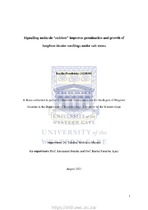| dc.description.abstract | Abiotic stress, mainly in the form of extreme temperatures, drought and salinity has caused major crop losses worldwide, putting a severe strain on agriculture. Salinity severely limits plant growth and productivity and affects all aspects of the plant’s development including the most crucial stage; germination. This study investigated the effect of salt (NaCl) stress on Sorghum bicolor seedlings and the role of exogenously applied calcium (Ca2+) to ameliorate the effects of salt stress during germination. Sorghum seeds were germinated in the presence and absence of various NaCl (100, 200 and 300 mM) and Ca2+ (5, 15 and 35 mM) concentrations. Several assays including physiological (germination and growth assays), biochemical (osmolytes and oxidative stress markers), anatomical (epidermal and xylem layers) and expression profiles of key genes [antioxidant (SbSOD, SbAPX2 and SbCAT3), Salt Overly Sensitive (SbSOS1, 2 and 3) pathway enzymes and the vacuolar Na+/H+ exchanger antiporter2 (SbNHX2)] were investigated. Salt stress delayed germination and negatively affected growth as observed by the reduced root and shoot length and decreased fresh and dry weight. There was an increase in proline content and oxidative stress markers (H2O2 and MDA) under salt stress. Oxidative stress resulted in damage to the epidermal and xylem layers as observed on Scanning Electron Microscopy (SEM) images. Quantitative real-time polymerase chain reaction revealed that salt stress
induced the expression of SbAPX2, SbCAT3 and SbSOS1 genes, whereas SbSOD4A, SbSOS2, SbSOS3 and SbNHX2 genes were not affected by salt. Exogenous application of Ca2+ counteracted the harmful effects of salt stress by improving germination efficiency, promoting seedling growth, reducing oxidative damage and the Na+/K+ ratio, indicating the protective effect. Ca2+ also effectively protected the epidermis and xylem layers from the severe damage caused by salt stress. In the presence of Ca2+ the expression of SbAPX2 and SbCAT3 was reduced except for the SbNHX2 gene, which increased by 65-fold compared to the control. The results obtained suggests that sorghum is able to respond to salt stress by inducing osmolytes, the antioxidant defence system as well as the SOS pathway. Furthermore, 5 mM Ca2+ was determined as the optimum Ca2+ concentration required to enhance sorghum’s tolerance to salt stress. | en_US |

